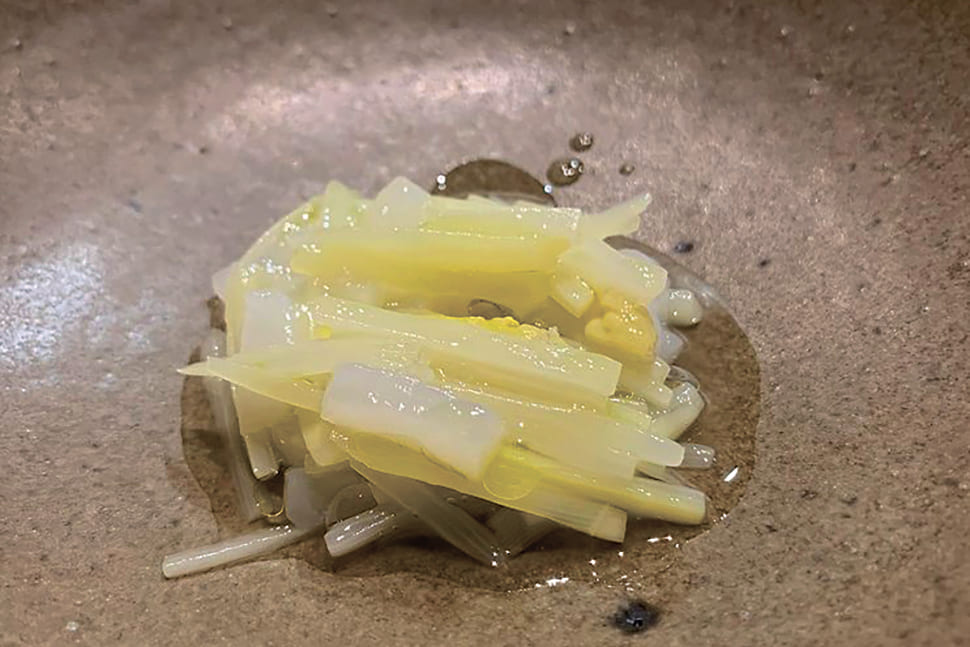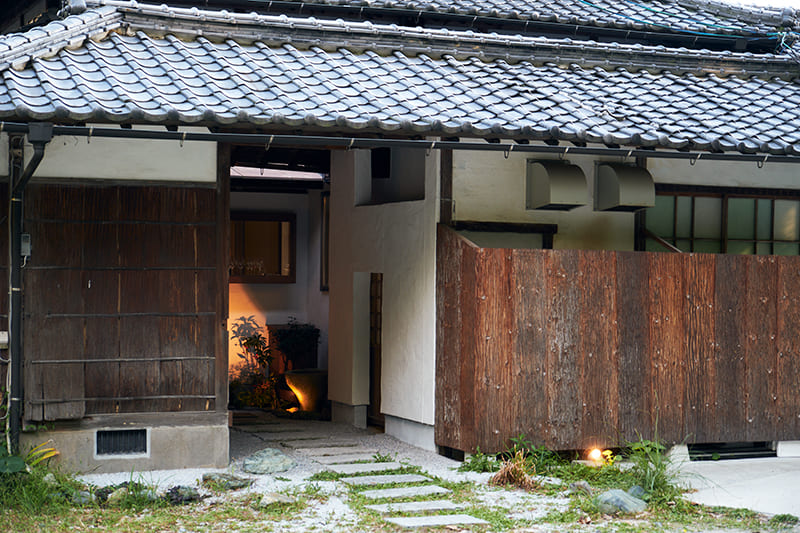DESTINATION RESTAURANTS
June 20, 2022
Akai
By TAEKO TERAO
PHOTO:KOUTAROU WASHIZAKI

Hiroshima Prefecture’s Itsuku-shima Shrine is a well-known World Heritage site. Ferries headed for the sacred island where it is located leave from Miyajimaguchi, a touristy neighborhood in the city of Hatsukaichi. Residential areas nestle closer to the foothills. The restaurant Akai occupies an 80-year-old house on a hill, just under 10 minutes on foot from the station.
Behind the eight-seat counter, Hiroshima-born chef and owner Kenji Akai brings his skills to bear. Following an apprenticeship at two well-known restaurants in France, he won the grand prix in 2017’s RED U-35, a competition for chefs under age 35. For both lunch and dinner, an omakase menu is the only option. The first dish is always a lacquer bowl of okayu, a simple rice porridge. Every week, the chef drives 40 minutes each way to collect the famously delicious water that flows in the town of Yukicho, in which he simmers Hiroshima-grown rice. Both the serving bowl and the food it contains are quintessentially Japanese. Additions vary with the seasons; in spring the okayu is studded with peas or onions, in winter with daikon radish. For Akai, the okayu with fresh peanuts that he serves in fall is a particularly special dish.
“I first made it four or five months after we opened in May 2019, and it was a turning point for me,” he noted. “Up till then, I used more ingredients in each dish, but this came together with hardly more than water, salt and the two main ingredients. I realized I didn’t need any more than that. This one dish determined the direction of the restaurant.”
The porridge is fragrant with fresh autumn rice and fresh peanuts harvested in October and November in Hatsukaichi. The simplicity of the dish leaves no room for culinary trickery, which is exactly why the quality of the ingredients — and the bounty of Hiroshima Prefecture — comes across so directly. Seasoned with salt and olive oil from Edajima, it pairs nicely with wine.
Akai keeps the focus on ingredients throughout the rest of the menu. Umazura hagi (black scraper), a white fish, is served as sashimi alongside a gelee with a dashi (broth) base. The savory custard of kōtake mushrooms and soft-shelled turtle broth is decisively a Japanese chawanmushi rather than a French flan. Fish and meat main dishes are grilled over charcoal. As fall turns to winter, wild meats such as onagagamo (northern pintail duck) caught in nets make an appearance. At the time of the interview for this article, Akai was serving ishidai (striped beakfish) from Yawatahama in Ehime Prefecture and ezoshika (Yezo sika deer) from Hokkaido.
“I use as many ingredients from Hiroshima as possible, but not because they’re from Hiroshima. I use them because I’m satisfied with the quality,” Akai said.
A French-style red wine sauce finally appears with the main meat dish.
“People often ask me about that,” he said. “Since I’m aiming for a flavor that’s not ‘too delicious,’ I almost never use French cooking techniques that concentrate umami. My cooking doesn’t fit any category. If I had to categorize it, I’d call it my personal style.”
Although the area is a famous tourist destination, until now it has had no gourmet restaurants. It is significant that Akai has chosen this area for his venture.
■Sustainable Japan Magazine (Sustainable Japan by The Japan Times)
https://sustainable.japantimes.com/magazine/vol18/18-05
■satoyama~Authentic Japan (Sustainable Japan by The Japan Times)
https://sustainable.japantimes.com/satoyama/102
■The Japan Times
https://www.japantimes.co.jp/life/2022/12/04/food/destination-restaurants-akai-hiroshima/









